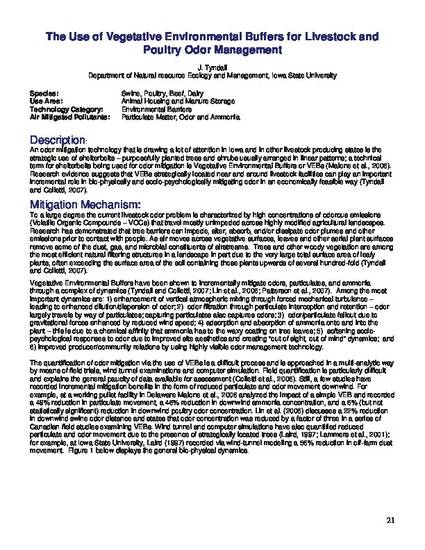
Article
The Use of Vegetative Environmental Buffers for Livestock and Poultry Odor Management
Mitigating Air Emissions from Animal Feeding Operations: Conference Proceedings
Document Type
Conference Proceeding
Disciplines
Conference
Proceedings of the National Conference on Proceedings of the National Conference on Mitigating Air Emissions from Animal Feedin Operations: Exploring the Advantages, Limitations, and Economics of Mitigation Technologies
Publication Version
Published Version
Publication Date
5-1-2008
Conference Title
National Conference on Proceedings of the National Conference on Mitigating Air Emissions from Animal Feedin Operations: Exploring the Advantages, Limitations, and Economics of Mitigation Technologies
Conference Date
May 19-21, 2008
Geolocation
(41.6005448, -93.60910639999997)
Abstract
An odor mitigation technology that is drawing a lot of attention in Iowa and in other livestock producing states is the strategic use of shelterbelts – purposefully planted trees and shrubs usually arranged in linear patterns; a technical term for shelterbelts being used for odor mitigation is Vegetative Environmental Buffers or VEBs (Malone et al., 2006). Research evidence suggests that VEBs strategically located near and around livestock facilities can play an important incremental role in bio-physically and socio-psychologically mitigating odor in an economically feasible way (Tyndall and Colletti, 2007).
Copyright Owner
Iowa State University
Copyright Date
2008
Language
en
File Format
application/pdf
Citation Information
John Tyndall. "The Use of Vegetative Environmental Buffers for Livestock and Poultry Odor Management" Des Moines, IowaMitigating Air Emissions from Animal Feeding Operations: Conference Proceedings (2008) p. 21 - 26 Available at: http://works.bepress.com/john_tyndall/17/

This proceeding is from Mitigating Air Emissions from Animal Feeding Operations: Conference Proceedings (2008): 21. Posted with permission.